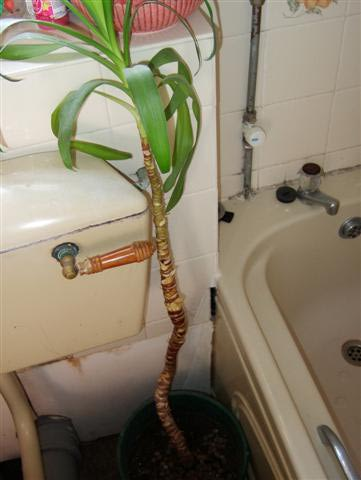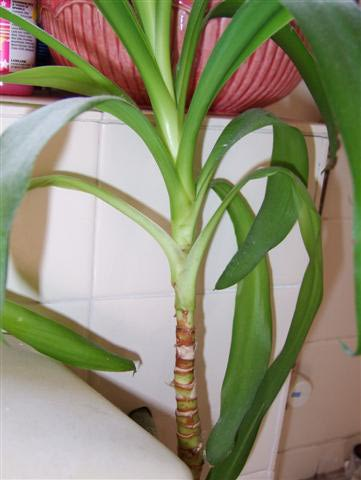Question
 Plant
Plant  Plant
Plant
I'm hoping that you can help me regarding a house plant which we assumed was a yucca but which has now been suggested as being a dracaena.
Unfortunately we had an infestation of black fly a few years ago which wiped out half of our house plants but this one made it through thankfully and has very healthy looking leaves.
The problem we have is that after losing most of the bottom leaves, it's very lanky and is getting top heavy; we're using a corner between the toilet and wall to keep it upright at the moment. We know we have to do something to save it and it seems the only option is to propagate it but frankly the idea scares us, as my husband took a cutting before and it didn't make it, but I have a hunch it was to do with the black fly infestation at the time.
I've been trawling the internet for a while now and we have been asking for advice from people we know and there seem to be many different methods, but as it's a drastic step, we want to make sure it has the best chance as we're very protective of it. The general advice we have had so far is -
1. Use cactus compost mixed 50/50 with sand.
2. Use a very sharp, clean knife to cut it into four or five sections.
3. Use rooting horm
one powder.
4. Make sure the pot used is clean and the compost new.
But then what is the next best step and how do we go about it? I've heard of air drying in an airing cupboard, lying the sections horizontally on the earth, simply potting them up, air layering and even placing in water to root but I worry that that would just rot the section. It seems to vary depending on what the plant is too, and as we now are unsure, it isn't as straightforward as we had first thought. I think we have but one chance with this as it only has the one stem so I would greatly appreciate your help, thank you.
AnswerHi Melanie,
Your plant is a Yucca elephantipes and not a Dracaena as you have been misinformed.
There is no one best way to propagate a Yucca cutting. Your particular plant is too weak to try air-layering, which might work otherwise. Taking stem sections and placing them horizontally on damp soil is also inappropriate for this particular form of Yucca elephantipes.
Your best option is to take a single cutting about 2-3 inches below the lowest leaves. Root that cutting in plain water or a very small pot (4 inches or less) filled with a porous potting mix. A standard soil-less, peat-based potting mix combined with perlite in a ratio of 5 to 1 would be best. Keep that potting mix slightly damp at all times, never allowing it to get completely dried out. If you root the cutting in water, move it to a similar pot and potting mix when the roots are about an inch long.
Compost is not sterile and should not be used. The basic potting mix should be peat-based and soil-less. If you cannot find that mix, use plain peat moss and perlite alone.
Rooting hormone provides very little benefit. Use it if you already have it, but otherwise, don't waste your money on it.
Once you have started propagating the cutting, make sure it gets lots of direct sunlight from a very sunny window and be sure to keep it as warm as possible. It is clear from the photo that you provided that your plant has gotten barely enough light to survive, but not enough to thrive. In addition, it is in a pot that is so large that it takes too long for the soil to dry out between waterings and that causes root rot.
If the roots and stem of the remaining plant from which you took the cutting are healthy, then you may get new foliage growth sprouting from just below the point where you made the pruning cut. Provide more light for it and water it very lightly.
The black flies did not kill your plants. They are fungus gnats and they survive in soil that is kept constantly moist. The moist soil causes root rot which the gnat larvae feed on and the root rot is what kills the plant. To prevent this from happening in the future, use only sterile potting mixes and avoid Miracle-Gro potting mixes. Be sue that you keep your plants quite potbound so they dry out quickly after each watering and be sure to allow the soil to dry out close to the wilt point before watering. These practices will prevent fungus gnats and keep roots from rotting.
I hope this helps clear up some of the confusion cause by your other non-professional sources of information.
I have written articles on fungus gnats and on Yucca care that I will email for free to you
(or anyone else) who emails a request to me at
[email protected].
Please let me know if any of this is unclear or if you have any additional questions.
If this information has been helpful, please click the Rate Volunteer bar below
and enter a rating and nomination for me. I am a volunteer on this site so
Ratings are the only compensation I receive for answering plant questions.
Need more information? Visit my website at:
A link to HorticulturalHelp.com
or email me at
[email protected] or call me at 917-887-8601 (EST)
牋
Regards,
Will Creed, Interior Landscaper
Horticultural Help, NYC
Visit my
website at:?lt;a href="http://www.HorticulturalHelp.com/">A
link to HorticulturalHelp.com</a>
?







